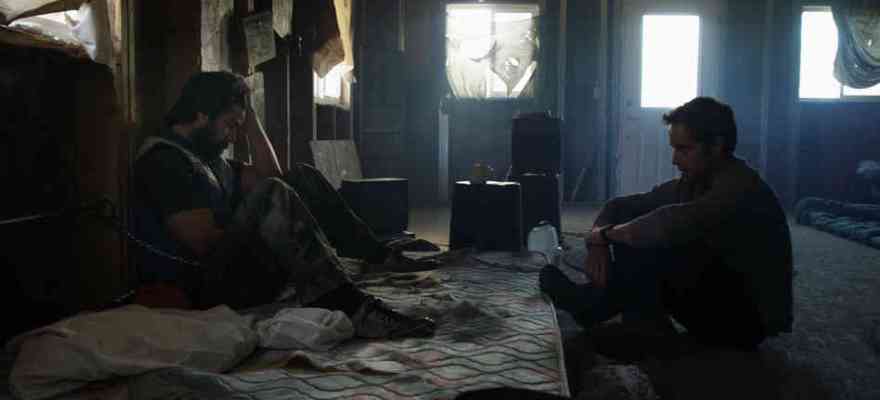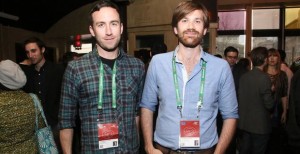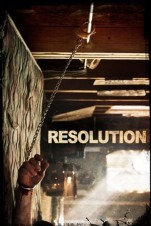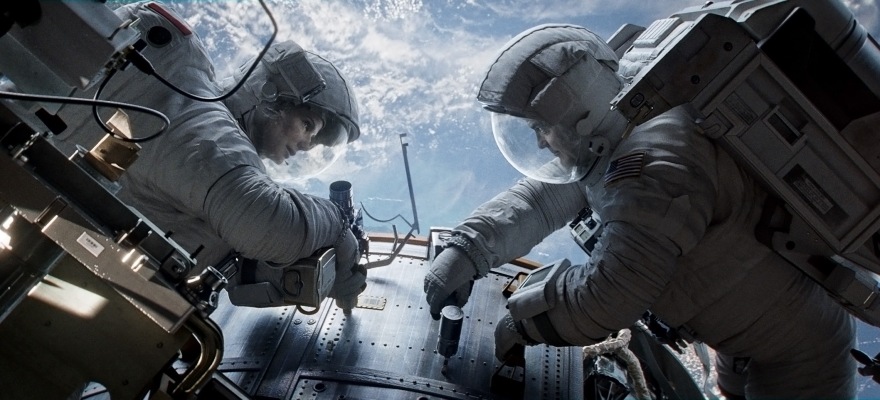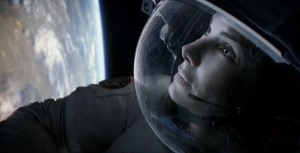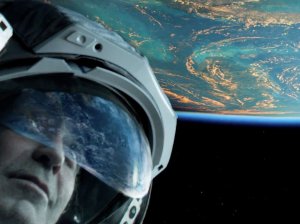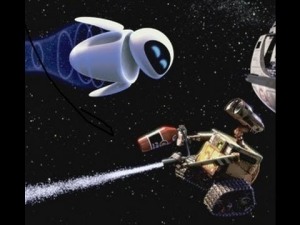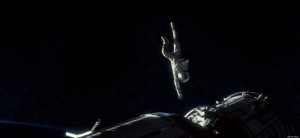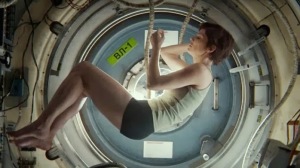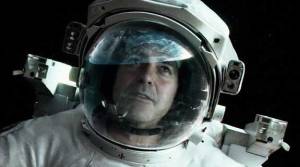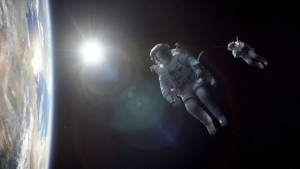When Justin Benson and Aaron Moorhead met, they were interns at Ridley Scott’s commercial production company. Soon they were working with each other on a variety of short films and spec advertisements, and when Justin approached Aaron with a genre-bending horror script called Resolution, they decided to pool their talents and resources to get it made.
Shot in 17 days on a tiny budget, the film snagged the attention of the Tribeca Film Festival and has since garnered rave reviews. Now available on iTunes and Netflix streaming, Resolution is scary, funny, conceptually unique, and definitely worth a watch.
I recently had the chance to speak with Justin and Aaron about the making of Resolution as well as their upcoming film Spring.
So you guys just got back from Italy?
Justin: Yeah, we just got back two weeks ago. We were there for six or seven weeks, shooting Spring.
So you’ve just shot principal photography then?
Justin: Yeah, we just finished. And we did a few days in the U.S.
Let’s talk about your first film, Resolution. What was your budget, how big was your crew, and what were the day-to-day logistics like?
Justin: Uh … I don’t remember, actually.
Aaron: I think we had ten people on set most of the time. For the final scene of the movie we were up to about eighteen people.
Justin: It was really small. The entire budget of the movie was tiny. Tiny, tiny, tiny, tiny, tiny. It was just our checking account.
That’s impressive. It really does not look or feel so cheap.
Aaron: The budget on Spring is literally … twenty-seven times the budget of Resolution.
(laughter)
Justin: But I think we can honestly say, from Resolution to Spring, you can tell on set we were getting more because we had more money. It looks like a much more expensive movie.
So on Resolution did you just have crew camp out at the cabin, or did they stay nearby and that place wasn’t as remote as it seemed?
Aaron: We actually worked out a deal with a Christian children’s camp. I’m not joking, they put us all up for some really, really dirt cheap price, I forget what it was. Like, $1,500 to house the entire crew for the whole entire shoot. Something like that? And it was a five minute drive to set. We got really lucky on that one.
Tell me about how you did sound on a shoestring budget.
Justin: What sound?
(laughter)
Justin: You’ll notice Resolution doesn’t have any score, so that approach required incredibly crisp sound. So we had this incredible field mixer, who is also a composer, named Dan Martinez, who rocked it. And we had another guy who was our re-recording mixer. Nobody worked entirely for free, but they might as well have, basically. So our re-recording mixer was this guy named Yahel Dooley who is like a third director to us, to be honest. He is one of the “must haves.” Some people don’t understand our movies until Yahel gets to it. Really, his sound is so critical and crucial to everything that we do, we absolutely need him. So he designed everything. Resolution had almost no ADR (Additional Dialog Recording), it had like a couple lines here and there. And it was all for clarity, it wasn’t even for beefing up the quality of the audio. Sound is of paramount importance to us. The mix was like fifty hours long because we were pulling a favor. We were sneaking into a post house to do it. So it was an insane thing. And Yahel just went with it, he was right there with us.
Aaron: He’s incredible, he’s our secret weapon.
You shot on the RED. At any point did you discuss using DSLRs to save money?
Justin: We did. We use DSLRs all the time for new media stuff, but there are things for example … actually, I’m going to let Aaron answer this.
Aaron: There are disadvantages to those little cameras. You can shoot features on them, The Battery was shot on one and it looks awesome. You can barely tell that it’s not a RED. But I love shooting features in 4k. Especially low budget indie stuff, because if you need more coverage you can punch in to a close up, or if something is too dark you can move stops … you just have more freedom going into post production than you would on a DSLR. And with DSLRs … you need other pieces of equipment to make them look good, you can’t just grab one and go shoot with it.
Justin: There is something about the small camera look that seems campy … it’s almost silly to debate the differences between DSLR and RED, nobody is going to say a DSLR is better than RED.
Aaron: When we were making the choice it was all just coming down to budget. I’ve shot five or six features on RED and we’ve shot about a million different things on DSLR, so it’s not even a choice beyond “can we afford it?” And we got it hooked up.
Justin: Also, as a story reason, Michael is also holding the film you’re watching on 35mm film. So there could have been a story reason as to why it’s not on film, but it’s a lot easier to swallow if it looks like film, and RED looks a lot like more like film than DSLRs.
What are some things you learned from Resolution that you’ll take with you on future projects and what are some things you’ll never do again?
Justin: Well, we had a script supervisor this time.
Aaron: Usually it’s more like we’ll pick up something during the process that we’ll take to the next one.
Justin: With Resolution there were no big continuity errors by some miracle, but there was one scene where we realized we had shot the end of the movie without Chris wearing the bandage he should have been wearing. It was like amateur hour.
Aaron: Our script supervisor was this document we made way in advance that listed the things we needed to watch out for in a scene. And we could just check it before every scene.
Justin: Sometimes we wouldn’t check it.
(laughter)
Aaron: Just dumb shit.
Justin: With production you don’t think, “oh I need a script supervisor!” you think “oh, I need a camera!” But our script supervisor on Spring was … I’m not shining anyone on, but I don’t think there are better script supervisors out there. I don’t think they exist, we got the best one.
Resolution was totally your movie but I’m assuming Spring had more outside funding. Did other people have a say in the finished film?
Aaron: That’s a great question because that was our worry. Resolution turned out well because we got to do what we wanted. We took whatever risks we could and tried to make a really interesting film. So on our next film, it was like “how are we going to do this without getting into bed with the wrong people? Do we want to make another film or hold on to our scruples?” And we ended up getting really lucky by not having any outside interference again. We have a financier that pretty much lets us do what we want and a cast that’s incredible. There’s always the game of casting for sale value versus talent and stuff like that. But Lou Taylor Pucci (Thumbsucker, Evil Dead remake) is the most talented mother f*cker on the planet and he’s awesome, really awesome. He just dives right into the role. In many, many ways we got super lucky. And we just have to keep hoping we get as lucky as we keep getting.
Talk about how the next film happened, since you made Resolution completely on your own. Did it help you get an agent or manager that hooked you up?
Justin: For Resolution we got really lucky and made it into a major film festival just by submitting. And then you end up surrounded by people on the business side of things that you build relationships with. Most of the people we did Resolution with were people that we ended up making Spring with, on the business side of things. As far as agent and manager, not so much. We have kind of a manager now but the thing is, as far as making stuff like Resolution and Spring, you make that stuff outside the system and it’s kind of separate from your agent and manager stuff, in a lot of ways. There’s basically a budget range at which you can make … let’s call it “unique material.” And once you go over that it’s like … you’ll get offers for remakes or things that are a very slight variation on something that already exists, and there’s nothing wrong with that, but you definitely can’t make stuff like Spring or Resolution within that system.
If someone offered you one of those remakes would you make it and learn on their dime, or would you rather plow ahead with your own stuff?
Justin: Honestly, it’s a delicate game of playing in both worlds because they both have their advantages.
When I watched Resolution I was really taken with how you used different types of scares … do you have a philosophy about what types of scares to use? And why? Or do you just go with your gut about what’s scary?
Aaron: There’s a little bit of theory behind it. We have kind of a cowboy approach when it comes to the tone of our films, where we just kind of go and make whatever the moment is work. If it’s scary we make it as scary as we can, if it’s funny we make it as funny as we can. And for scares … it’s very rare that we’ll time a jump scare. That’s not really our thing. Sometimes it happens, but if it happens every five seconds and the person (in the movie) is like “damn, you’re always trying to fool me!” to be honest that’s like the worst jump scare in the world. And it happens way to often. But if you can get it right it’s just awesome. Our favorite thing, honestly, is just tone. When you can scare people with just the tone of dread and building unease and combine that with something that is conceptually unique and frightening, that’s our favorite thing. If we can find that and really scare people with it, that’s really cool.
The one jump scare that stands out is when Michael (Peter Cilella) goes into the cave, but even though it’s not “the monster” of the film, it’s still a scary scenario.
Justin: With supernatural horror, the hardest thing is to sit there and try to come up with new things that are scary. It’s really tough. Even if you watch something like The Conjuring which is effective, but every single thing in it has been done before. It’s tough to break new ground. When you really think about it, we’re living in a world where people have been trying to make myths since [civilization] has existed, so 4,000 years of people trying to outdo you and you have to sit at your desk and try to think of something that is hopefully not derivative and can still scare people in a new way …
Aaron: Or if not scare you then resonate with people and make people think a little bit about their humanity. Anything that can turn that on its head … and that’s the thing about Justin’s writing, he’s always trying find a way around what’s already been done. That’s one of the reasons we both get along so well, because we both mutually feel like you could do things that have been done before really well and people may like it, but it’s just already been done so it’s uninteresting to us. Not that we’re the most original filmmakers in the world, though we strive to be, but you can never get away from your past.
(pause)
That sounded way more epic than I mean, but you know what I mean.
*laughter*
Aaron: It’s always funny when people say our stuff is original and we say that’s what we’re striving for … but on the poster is a cabin in the woods.
It’s a tough balance, because the audience does come back to see tropes. I remember seeing the poster with the arm handcuffed to the wall and thought it might be “torture porn” (which it isn’t). But while having a character handcuffed to the wall is a major element in the story, it’s not the whole movie, though I can see why they chose that image to promote it.
Justin: We mostly made that poster ourselves and we were trying to get something that was very evocative, that you’d look at and have kind of a visceral reaction. In hindsight it might sell the movie differently than it is, but what it does do — because right now it’s the DVD cover — is that it intrigues a lot of people. And even though that’s slightly different sometimes than you’re expecting, how do you sell the visual of Resolution? What is THE visual of the movie? Well, it’s a voyeuristic mind twist … how do you find the visual for that? You know?
Absolutely. To be clear, I didn’t know you guys designed the poster and I wasn’t trying to critique the quality.
Justin: No, we feel the same way! It’s totally fine.
It’s so true that Resolution has a complex idea behind it. Can you talk a little bit about how you juxtaposed the supernatural force in the movie with the addiction of Chris (Vinny Curran)? Was that your plan from the start or did it develop along the way?
Justin: The supernatural mythology came first and the character drama came second, just in the writing process. But then in the total making of the film they’re of equal importance. But to be totally honest the first thing that came to my brain was the mythology. And it’s weird. Aaron and I have made three of four things now with some kind of supernatural mythology, and with two out of those three there’s so much done with suggestion. There are whole worlds of mythology we’ve developed in at least two projects — one is a short film we’ve got coming up — that go really deep and there’s a lot suggested … but it’s fun not to get too far into it in the actual story. In Spring we get pretty far into the mythology. We talk about it explicitly quite a bit.
So much of horror is about what you don’t know and mythology is a tool we use to explain things. Do you fight for the balance to have enough info for the audience to make sense of things while keeping things vague enough to be scary?
Justin: With everything in film making you have the issue of how much you are showing and how much you are telling. I think what Aaron and I have found with the last few projects is that you just have to do both a lot. You can do the kind of film school thing where it’s just showing and you end up with something like “wow, it’s so Lynchian!” And that’s great, but if you’re not doing a story about a vampire or a werewolf or something, with a mythology that people have engrained in them, if you’re not talking about what you’re showing it’s a very different experience. And the degree to which people comprehend what is going on will be much lower. But that’s always a challenge, showing versus telling, and how much to do each.
Aaron: Whenever you think about a film with no dialog you think “impressive! Cool!” But every time I’ve ever watched a film with no dialog, I think “this is weird and they trying really hard.” The only time I’ve seen it work is in like the first nine minutes of There Will Be Blood. And why? Because he’s alone! Then as soon as he’s with people he starts talking.
Justin: At this point you could probably do any variation on the zombie mythology without dialog and people would get it. (laughs) That might be kind of an interesting thing, a really meditative, poetic zombie movie. People would totally get it.
I think a lot of indie films get basic coverage of a scene but don’t have the time or money to select shots that really get the film to the “next level” and have meaning to them. Were there sequences in Resolution that you wanted to film but couldn’t?
Aaron: Honestly, that was one of the reasons when Justin came to me with this script, that I came on board. We weren’t going to be like wearing our father’s shoes with the story, because it required the aesthetic. If we had a hundred million dollars to shoot this movie, it would have looked exactly the same. It’s the only way it could have looked. It has to be this kind of voyeuristic, naturalistic thing. It has to look this way because there’s a story reason for it. So when Justin and I were talking about how to approach the movie, we spent a lot of time on location and we figured out what looks the best. At least so we’re not looking at garbage, you don’t hate looking at the movie because it’s a bunch of plaster white walls and shitty lighting. We were designing an approach of beautiful naturalism. We didn’t actually reference any movies, but the one person who does this really well is Terrence Malick. Now the movie doesn’t look anything like Terrence Malick, but his approach is the same. You don’t think “oh, that was well done lighting” or “oh, that gaffer was great!” instead it feels like “oh, that gaffer didn’t have to work very hard because the lighting was already beautiful.” Now our gaffer did work very hard, but we worked to make it look as natural as possible. The camera work had to have a natural point-of-view look that actually was in the script. It was written as “halfway between Steadicam and handheld” and we got this big rig that kind of looks like a scorpion that hangs the camera off my shoulder and we were able to kind of get that look. Here and there the rig doesn’t hold up, but mostly it did. And we shot Spring the same way, we ended up liking it that much.
I’ve read that you had three months of rehearsal time with your main actors. How essential was that to the finished product?
Justin: Yeah, I think the most important part leading up to production is the rehearsal time with the actors. We actually re-write the script, the dialog, and tailor fit it to the actors. That’s how you get it looking like it was improvised. There’s almost nothing improvised, we just go through a really long rehearsal process and make sure everything is really naturalistic and conversational. Actually, it’s a thing that’s kind of scary, because as we move up in budget we’ll have to go to producers one day and say “we want to bring our actors to set three weeks before filming.” I think we save our producers money, though. Everything is really worked out before we get to set.
Aaron: It’s no joke. I don’t think any producer would believe it but that’s only because they don’t ever actually get three weeks of rehearsal so they don’t see the results. But we barely ever have to clear the set for blocking or work out kinks, because they’re already worked out a week ahead of time. It sounds like we’re just being idealistic, but actually as producers ourselves in addition to directing, we would insist on it not just for the performance but it also saves a lot of time on set.
Justin: We did nine hour work days in Italy. That’s just what they do. Normally it’s twelve over here, twelve plus, so losing one quarter of our day, the only reason we were able to make it was because our actors were so on point. And the same thing with Resolution, we had short days on Resolution. They just knew their character and walked right into it with very little adjustment. That was worked out so much earlier they had been able to think about it and process it. Honestly, I’ll say it again. With Resolution and Spring we just got super lucky because with Resolution we had that cabin accessible, so we’d just go block it out in the cabin. And even if we couldn’t, the guy’s handcuffed the whole time, you know? In Spring we took over that little city basically, that little town we were shooting in, and we were able to just go to every single location to block it out. That said, we know we can’t always block it out, it’s just always preferable.
Aaron: And it’s better for the actors, not just for timing but to be able to actually see where we’ll be shooting.
Justin: I wanted to say another thing about the way Aaron lights, is that it’s doubly impressive. I think as far as the realm of indie film goes, he is in my opinion the best DP. Everything looks amazing. But what’s especially impressive is that when we get to set he lights in such a way that he’s thinking about how we’re not going to be able to do a major relight as we establish all these things, yet he’s still making it look really good.
Aaron: The reason Soderbergh shoots all of his own stuff is because it’s just one less conversation. In our case, obviously both of us are really into aesthetics, as a filmmaker you have to be, but always when a choice comes down to more time shooting an actor’s face or more time lighting, the good news is that because I’m directing and shooting and Justin is right there with me, we can always make the right choice which is shoot more time with the actor’s talking. The actors are going to look beautiful because they’re beautiful people, and as long as my lighting isn’t garbage then we can do something for them. But, getting them more takes, letting them “feel it” is so much more important than saying later “at least it was lit beautifully but the performance was off.” No one ever says that.
Speaking of which, I thought the acting from secondary characters in Resolution was very good, notably Zahn McClarnon who played Charles. Did you have to change your approach with him given the fact you didn’t have three months of rehearsal?
Justin: Always with day-players or people that come for just a couple of days, you spend a lot of time casting. What is that saying, 90% of directing is casting? In the case of day-players you just do a really thorough audition process and hope you get your first choice (which in that case, Zahn was our first choice). And then you pray and then they come to set. You can say a few things to them, but there’s to trick to directing. You need to speak clearly and be a good communicator, but once you tell them what you want … you just hope.
Justin and Aaron are currently in post-production on Spring. If you’d like to watch their current work, check out Resolution via iTunes or Netflix streaming, or check out their short films on YouTube:
